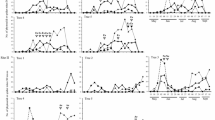Abstract
A population survey of phytoseiid mites and spider mites was conducted on peach leaves and wild plants in Japanese peach orchards having different pesticide practices. The phytoseiid mite species composition on peach leaves and wild plants, as estimated using quantitative sequencing, changed during the survey period. Moreover, it varied among study sites. The phytoseiid mite species compositions were similar between peach leaves and some wild plants, such as Veronica persica, Paederia foetida, Persicaria longiseta, and Oxalis corniculata with larger quantities of phytoseiid mites, especially after mid-summer. A PCR-based method to detect the ribosomal ITS sequences of Tetranychus kanzawai and Panonychus mori from phytoseiid mites was developed. Results showed that Euseius sojaensis (specialized pollen feeder/generalist predator) uses both spider mites as prey in the field.








Similar content being viewed by others
References
Abbas MN, Rana SA, Khan HA, Khalil-ur-Rehman (2012) Status of trophic guild of invertebrates utilizing weeds of wheat and sugarcane fields of Faisalabad. Pak J Agric Sci 49:189–198
Aguilar-Fenollosa E, Ibáñez-Gual MV, Pascual-Ruiz S, Hurtado M, Jacas JA (2011) Effects of ground-cover management on spider mites and their phytoseiid natural enemies in clementine mandarin orchards (II): top-down regulation mechanisms. Biol Cont 59:171–179
Amano H, Ishii Y, Kobori Y (2004) Pesticide susceptibility of two dominant phytoseiid mites, Neoseiulus californicus and N. womersleyi, in conventional Japanese fruit orchards (Gamasina: phytoseiidae). J Acarol Soc Jpn 13:65–70
Coli WM, Ciurlino RA, Hosmer T (1994) Effect of understory and border vegetation composition on phytophagous and predatory mites in Massachusetts commercial apple orchards. Agric Ecosyst Environ 50:49–60
Ehara S, Gotoh T (2009) Colored guide to the plant mites of Japan. Zenkoku Noson Kyoiku Kyokai, Tokyo (in Japanese)
Ferla NJ, Marchetti MM, Gonçalves D (2007) Ácaros predadores (Acari) associados à cultura do morango (Fragaria sp., Rosaceae) e plantas próximas no Estado do Rio Grande do Sul. Biota Neotropica. Campinas 7:1–8
Gerson U, Weintraub PG (2007) Mites for the control of pests in protected cultivation. Pest Manag Sci 63:658–676
Grafton-Cardwell E, Ouyang Y, Bugg RL (1999) Leguminous cover crop to enhance population development of Euseius tularensis (Acari: phytoseiidae) in citrus. Biol Cont 16:73–80
Gravena S, Coletti A, Yamamoto PT (1993) Influence of green cover with Ageratum conyzoides and Eupatorium pauciflorum on predatory and phytophagous mites in citrus. Bull IOBC-SROP 16:104–114
Helle W, Sabelis MW (1985) World crop pests. Spider mites: their biology, natural enemies and control, vol 1B. Elsevier, Amsterdam
Inoue K, Ashihara W, Osakabe Mh, Hamamura T (1983) Predator fauna on windbreaks around citrus groves. Jpn J Appl Entomol Zool 35:49–56 (in Japanese with English summary)
Jeyaprakash A, Hoy MA (2002) Mitochondrial 12S rRNA sequences used to design a molecular ladder assay to identify six commercially available phytoseiids (Acari: phytoseiidae). Biol Control 25:136–142
Kishimoto H (2002) Species composition and seasonal occurrence of spider mites (Acari: tetranychidae) and their predators in Japanese pear orchards with different agrochemical spraying programs. Appl Entomol Zool 37:603–615
Kishimoto H, Teshiba M, Kondoh T, Miyazaki T, Sugiura N, Toda S, Yamasaki R, Wakatsuki H, Motoyama H, Horie H (2007) Occurrence of Neoseiulus californicus (Acari: phytoseiidae) on citrus in Kyushu district, Japan. J Acarol Soc Jpn 16:129–137 (in Japanese with English summary)
Liang W, Huang M (1994) Influence of citrus orchards ground cover plants on arthropod communities in China: a review Agriculture. Ecosyst Environ 50:29–37
Mailloux J, Le Bellec F, Kreiter S, Tixier MS, Dubois P (2010) Influence of ground cover management on diversity and density of phytoseiid mites (Acari: phytoseiidae) in Guadeloupean citrus orchards. Exp Appl Acarol 52:275–290
Marčić D, Perić P, Milenković S (2011) Acaricides—biological profiles, effects and uses in modern crop protection. In: Stoytcheva M (ed) Pesticides—formulations, effects. fate, InTech, Rijeka, Croatia, pp 37–62
McMurtry JA (1992) Dynamics and potential impacts of “generalist” phytoseiids in agrosystems and possibilities for establishment of exotic species. Exp Appl Acarol 14:371–382
McMurtry JA, Croft BA (1997) Life-styles of phytoseiid mites and their role in biological control. Annu Rev Entomol 42:291–321
Muma MH (1961) The influence of cover crop cultivation on populations of indigenous insects and mites in Florida citrus groves. Fla Entomol 44:61–68
Navajas M, Lagnel J, Fauvel G, De Moraes G (1999) Sequence variation of ribosomal internal transcribed spacers (ITS) in commercially important Phytoseiidae mites. Exp Appl Acarol 23:851–859
Nomikou M, Janssen A, Schraag R, Sabelis MW (2002) Phytoseiid predators suppress populations of Bemisia tabaci on cucumber plants with alternative food. Exp Appl Acarol 27:57–68
Osakabe M, Inoue K, Ashihara W (1987) Effect of Amblyseius sojaensis Ehara (Acarina: phytoseiidae) as a predator of Panonychus citri (McGregor) and Tetranychus kanzawai Kishida (Acarina: Tetranychidae). Appl Entomol Zool 22:594–599
Ozawa M, Yano S (2009) Pearl bodies of Cayratia japonica (Thunb.) Gagnep. (Vitaceae) as alternative food for a predatory mite Euseius sojaensis (Ehara) (Acari: phytoseiidae). Ecol Res 24:257–262
Smith D, Papacek DF (1991) Studies of the predatory mite Amblyseius victoriensis (Acarina: phytoseiidae) in citrus orchards in south-east Queensland: control of Tegolophus australis and Phyllocoptruta oleivora (Acarina: Eriophyidae), effect of pesticides, alternative host plants and augmentative release. Exp Appl Acarol 12:195–217
Sonoda S, Kohara Y, Toyoshima S, Kishimoto H, Hinomoto N (2012) Phytoseiid mite species composition in Japanese peach orchards estimated using quantitative sequencing. Exp Appl Acarol 6:9–22
Tanaka M, Kashio T (1977) Biological studies on Amblyseius largoensis Muma (Acarina: phytoseiidae) as a predator of the citrus red mite, Panonychus citri (McGregor) (Acarina: Tetranychidae). Bull Fruit Tree Res Stn Jpn D1:49–67
van Lenteren JC (2001) A greenhouse without pesticides: fact or fantasy? Crop Prot 19:375–384
Acknowledgments
This work was financially supported by the Ministry of Agriculture, Forestry and Fisheries, Japan through a research project entitled ‘Development of technologies for mitigation and adaptation to climate change in Agriculture, Forestry and Fisheries’ and the Ohara Foundation for Agricultural Research.
Author information
Authors and Affiliations
Corresponding author
Rights and permissions
About this article
Cite this article
Wari, D., Yamashita, J., Kataoka, Y. et al. Population survey of phytoseiid mites and spider mites on peach leaves and wild plants in Japanese peach orchard. Exp Appl Acarol 63, 313–332 (2014). https://doi.org/10.1007/s10493-014-9788-9
Received:
Accepted:
Published:
Issue Date:
DOI: https://doi.org/10.1007/s10493-014-9788-9




